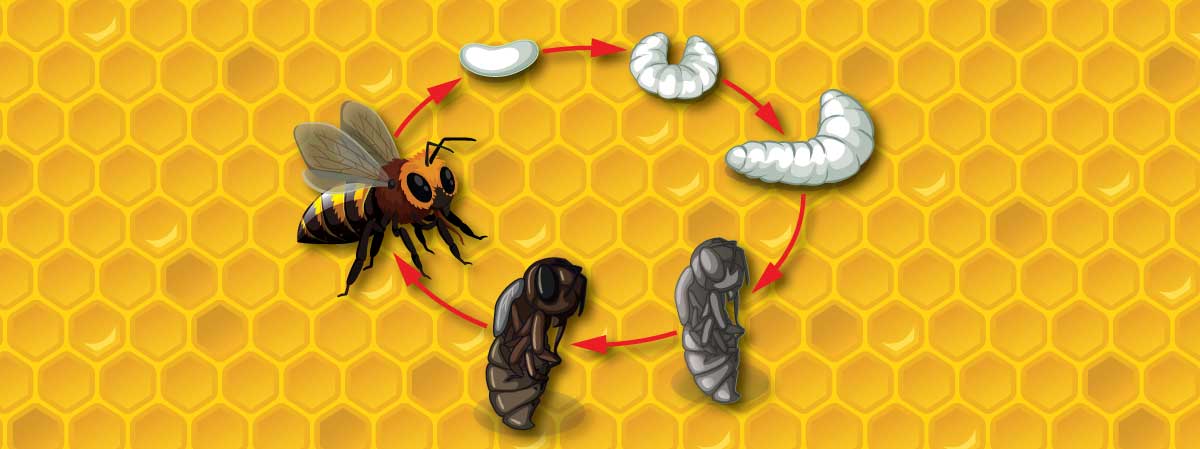The body of bees evolves in three different forms: let's discover its development cycle
Bees are very complex and very interesting animals. The development cycle of a bee follows very specific processes that start even before laying an egg.
Bees are born from the eggs laid by the queen bee. Each egg is placed in a reserved cell. The development times of a bee vary according to sex and whether it is a queen bee or a worker bee or a drone.
Let's find out more about the metamorphosis of the body of bees and the stages of development of a larva.
Queen bee and spawning
A typical colony of bees is made up of three types of bees: queen bees, worker bees and drones (male bees).
The queen bee is the only female in the colony capable of laying eggs. The queen mates with a large number of drones from other colonies, which die soon after mating. Following the nuptial flight (mating with the drones) the queen has stored enough seed in her body to produce fertilized eggs for the rest of her life. The queen bee can choose in advance whether she will lay eggs from which females or males will be born. Female bees are born from fertilized eggs, while drones are born from unfertilized ones.
The queen lays a very large number of eggs per day, if in good health, a queen bee can even lay 2,000 eggs per day!
The queen lays her eggs inside the hexagonal cells which are then sealed with a layer of wax. The larvae are fed by the other bees until they reach the adult stage. Once the metamorphosis is complete, the bees begin to collaborate with the rest of the swarm from the first moments of life. The first thing a bee does after it flickers is to clean its body and the inside of the cell to prepare it to host the eggs that will be laid later.
The development cycle of a bee varies according to the type of bee in the colony. Worker bees usually develop in about 21 days, queen bees in 18 and drones have a slower development (about 24 days).
How the body of bees changes: the metamorphosis

After the egg has been deposited inside the cell, the metamorphosis of the bee begins. The eggs remain in their original form for three days. When the egg reaches the bottom of the cell, embryonic development is complete.
Three days after laying, the body of a bee has already undergone its first metamorphosis: from egg to larva. The larvae have the appearance of a worm and have no legs. After four days, the larva comes out of the egg always remaining inside the cell.
During this phase, the larvae are fed royal jelly for three days and then they will be given honey and pollen. Royal jelly is a prized food. The larvae are entitled to it only for a few days while the queen bees feed on this substance for their whole life.
By the seventh day, the larva's body takes up almost all of the cell space. Here the workers seal the cells with a layer of wax (capped cells) in order to allow the larvae to complete development.
On the tenth day the larva reaches the state of eopupa : it develops its mouthparts, eyes, wings and legs. By the 12th day, the bee almost reaches its final shape: during this phase the bee is defined as a pupa.
The last changes that the pupa undergoes before its complete development in the adult stage concern the color of the eyes and the body. On the 19th day the body darkens and the bee has reached its final appearance.
After 21 days from egg laying, the development cycle finally ends: the adult bee emerges from its casing, breaking the operculum with its jaws to exit the cell (flickering). A bee that has reached its adult stage weighs about 100mg.
What do adult bees do?
Within the hive, each bee has a well-defined role. The worker bees are those that perform more tasks, dividing the tasks according to the needs of the hive.
Worker bees live for about six weeks during the summer months and much less during the winter months. The workers are females who work inside the hive collecting pollen and nectar to feed the larvae and other members of the colony. The worker bees are the ones that produce honey and royal jelly but also build the cells through the production of wax.
The worker bees take care of all the other daily activities of the hive, such as maintaining the temperature, cleaning the colony, removing carcasses and defending against predators. The queen bees take care only of laying eggs and guarantee the replacement of bees, while the drones have only a marginal role and are generated only when there is enough food to keep them.
Are you a beekeeper? Buy queen bees for your farm
If you need to buy bees for your farm, choose Apicoltura Laterza! For years we have been engaged in the production and sale of queen bees of Ligustica breed and Buckfast , the sale of bee cores on 5 frames and bee packs.
We also deal with the sale of the highest quality wholesale and retail honey.
You can order our products directly online in a few clicks. We use professional and safe methods for shipping our bees. You will receive the bees in full force!
Want to find out more? View availability in real time and buy in a few clicks on the website: www.apicolturalaterza.it

 English
English  Italiano
Italiano  Estonian
Estonian  Finnish
Finnish  Français
Français  Deutsch
Deutsch  Latvian
Latvian  Norsk
Norsk  Polski
Polski  Română
Română  Español
Español  Svenska
Svenska